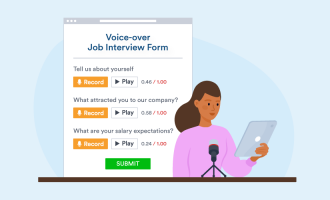The quality of your survey data depends on many factors — and the people you choose to collect data from are a significant factor! If you’re questioning the wrong people in relation to your goals, the data you collect won’t be very useful.
This is where purposive sampling comes in. Many researchers and organizations use purposive sampling to enhance their qualitative research because it can improve the quality of the responses they get.
But what is purposive sampling, and why should you use it in your data-collection efforts? We’ll get into all that and more in this article.
An overview of purposive sampling
Simply put, purposive sampling is a research method that involves choosing research participants “on purpose” rather than at random.
Also known as judgmental sampling, selective sampling, or subjective sampling, purposive sampling involves choosing participants according to certain criteria or attributes that relate to specific research goals. Businesses use purposive sampling for market research, and researchers use it when conducting academic research. This form of sampling can be used for surveys, focus groups, one-on-one interviews, and other data-collection methods.
Purposive sampling is common in smaller studies with limited sample sizes. It’s generally used more often for qualitative research rather than quantitative research. This type of research strategy enables researchers to gather in-depth data about a particular subject from people who are knowledgeable about it.
For example, if a researcher wanted to learn more about the effects of postpartum depression on new mothers, instead of surveying all new mothers, they could use purposive sampling to survey only mothers who’ve experienced postpartum depression.
People often confuse or conflate convenience sampling, another data-collection method with purposive sampling. However, they’re different approaches. Convenience sampling involves selecting a group of participants based on convenience for the researcher, such as people who are geographically close or readily available. It doesn’t involve choosing participants according to specific criteria or attributes like purposive sampling does.
Steps for conducting purposive sampling
The first step in purposive sampling is to define the problem you’re trying to solve. Having a clear goal for your research will help you determine what type of people you need to survey.
For example, let’s say a business wants to understand how to price its products for a holiday promotion. In this case, the best people to survey are those who’ve recently purchased their products at a specific price. Those people can offer insight about products’ value for the money — information the business can then use to develop a pricing strategy.
There are different research methods you can use with purposive sampling based on the goal you’re trying to achieve. Here are some examples:
- Typical case sampling: This method is best when researchers want to know the typical experience of a particular group so they can better spot trends and anomalies. In this case, they’d choose participants who’ve had a certain experience in a specific situation.
- Maximum variation sampling: When researchers want to better understand the diversity of experience within a particular group, they can use maximum variation sampling. It involves selecting participants who have a range of variations, characteristics, or experiences within a particular group.
- Homogeneous sampling: On the other end of the spectrum is homogeneous sampling, which involves selecting a sub-group of participants within a particular group of people. It helps researchers learn in-depth information about a particular characteristic or attribute.
- Expert sampling: This methodology is useful when researchers want to hear from experts in their field or people who have special knowledge about a specific subject. It’s useful for understanding a topic more deeply. Researchers can then use that information to develop further studies.
- Critical case sampling: If researchers want to understand the experiences of key people within a particular population or learn about critical experiences of a particular population, then critical case sampling is the best way to go. It involves choosing participants who are central to the research question.
- Extreme or deviant case sampling: You can use this methodology when you want to know about unusual experiences within a particular population. It involves surveying participants who have special characteristics within the specific group.
The advantages and disadvantages of purposive sampling
Purposive sampling allows researchers to gather in-depth data on a particular topic from people who are relevant to the goal the researcher is trying to achieve.
Purposive sampling is also more cost-effective than other sampling methods because it doesn’t involve finding random participants. Researchers also usually conduct purposive sampling on a much smaller scale than other types of studies, which makes it less expensive.
However, purposive sampling also comes with some drawbacks that are important to note.
Because of the small sample size in purposive sampling, it’s difficult to generalize the findings to a larger population. The small sample size can also cause sampling errors that can affect the reliability of the study.
Another issue to watch out for in purposive sampling is bias. Because this research methodology requires the researcher to select the participants according to their judgment, they may unknowingly insert their own bias at this stage by selecting people who fit their preconceived notions of a particular group.
Purposive sampling use cases
While purposive sampling isn’t a research methodology that works in every scenario, it can be particularly useful in certain industries. Here are some example uses cases for purposive sampling:
- Business: Organizations that want to learn more about a niche of their target audience can survey them about their product preferences. The business can use this information to make strategic decisions about product development, pricing, marketing, and more.
- Healthcare: Medical researchers may use purposive sampling to learn more about the experiences of patients dealing with certain illnesses. For example, they may conduct a study on people who suffer from chronic illnesses and generalize the data to determine specific care policies.
- Education: Administrators can use purposive sampling to get student feedback on specific educators, classes, curricula, or other aspects of the school and use the insights to make changes.
- Human resources: In order to choose the right candidate for the job, human resources professionals may pool candidates into groups, such as those who went to a specific school or had a certain major, and gain insights from them about career choices.
- Politics: To get a better understanding of what issues matter to voters, some political organizations use purposive sampling to get in-depth information on which issues the voters care about, what types of policies they want to see, who they plan to vote for in the next election, and more.
Jotform: An excellent resource for purposive sampling data collection
Jotform is a leading data-collection tool that researchers can use for purposive sampling and many other data-collection methods.
With thousands of templates for surveys, questionnaires, polls, quizzes, and more, Jotform saves you time and energy in the creation stage. Just use a template and customize the survey you want by changing the text, structure, and design instead of creating every new survey from scratch. You can also easily share your survey with participants via email, link, or QR code with Jotform.
When it’s time to analyze the responses, you can use Jotform Tables, a powerful database tool, to manage, track, and organize your data. And if you want to see visual representations of the data, Jotform Report Builder can help you create beautiful reports with graphs and charts. These tools help you gain insights from survey responses and turn raw data into valuable and actionable information.
No matter the type of surveying you’re doing, Jotform has everything you need to make data collection easy and successful.
Photo by Studio Republic on Unsplash































Send Comment: